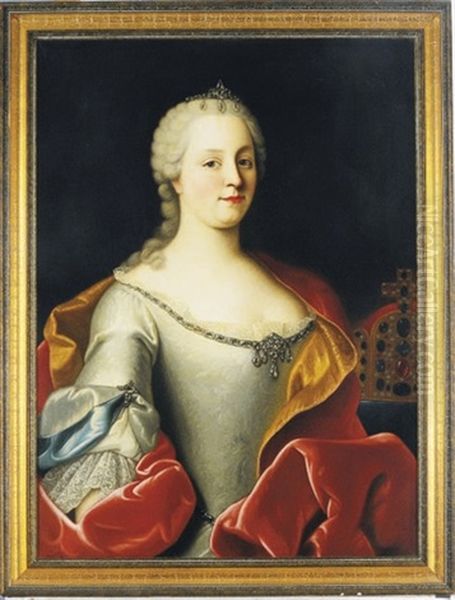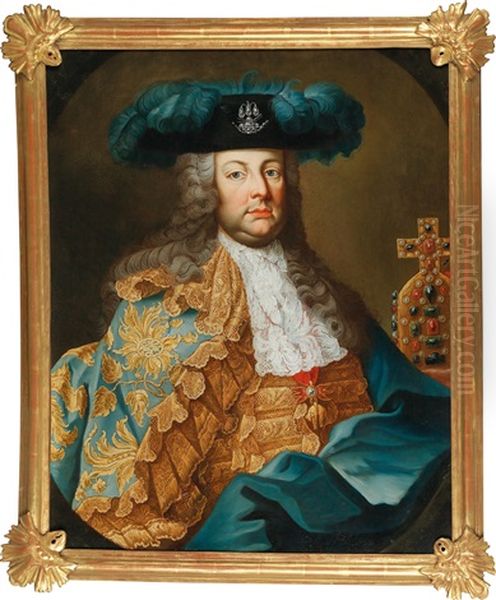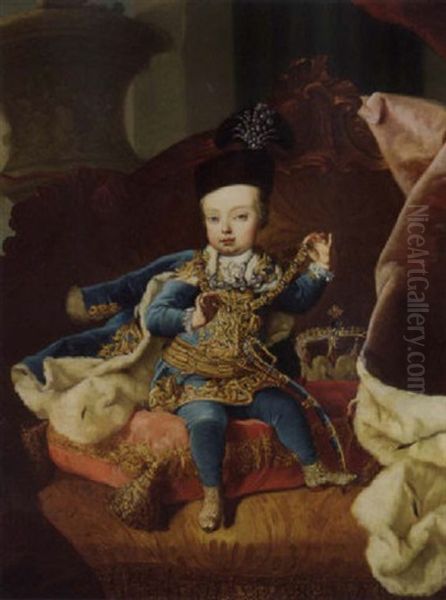Martin van Meytens the Younger stands as a pivotal figure in 18th-century European art, particularly renowned for his role as the preeminent court painter to the Habsburg dynasty in Vienna during the reign of Empress Maria Theresa. Born in Stockholm, Sweden, in 1695 and passing away in Vienna in 1770, Meytens' life and career bridged multiple artistic centers and traditions, culminating in a distinctive style of formal portraiture that defined the visual representation of imperial power and aristocratic elegance in Central Europe for decades. His meticulous technique, refined compositions, and prolific output cemented his legacy as the visual chronicler of the Theresian era.
Early Life and Artistic Formation
Martin van Meytens the Younger entered the world in Stockholm on June 16th or 24th (sources vary slightly on the exact day), 1695. Artistry was in his blood; his father, Martin van Meytens the Elder (1648–1736), was a Dutch painter who had settled in Sweden and gained considerable recognition himself. The elder Meytens provided his son with his initial artistic training, grounding him in the Netherlandish traditions that emphasized careful observation and skilled rendering. This familial connection provided a crucial foundation for the younger Meytens' future success.
Seeking broader horizons and specialized skills, the young artist left Sweden. His travels first took him to England, where he dedicated himself to mastering the intricate art of enamel painting. This technique, demanding precision and a delicate touch, likely honed his eye for detail. From London, Meytens moved to Paris around 1717. The French capital was then the undisputed center of European art and fashion, and Meytens immersed himself in its vibrant artistic scene. He studied enamel painting further under the renowned practitioner Charles Boit, a fellow Swede working in France. During his time in Paris, Meytens gained commissions, reportedly working for figures such as the Regent, Philippe II, Duke of Orléans, and even Tsar Peter the Great during the latter's visit.

His skill in miniature painting, often on enamel or ivory, brought him early acclaim. These small-scale works required immense precision and captured the refined tastes of the aristocracy. However, Meytens harbored ambitions beyond miniatures. His journey continued southward, leading him to Italy, a destination considered essential for any aspiring artist seeking to engage with the masterpieces of the Renaissance and Baroque periods.
The Italian Sojourn and Transition to Oil
Between approximately 1721 and 1730, Martin van Meytens travelled extensively throughout Italy, absorbing the artistic lessons of Venice, Rome, Florence, Bologna, Modena, Milan, and Turin. This period proved transformative. While he continued to create miniatures, Italy exposed him more fully to the grandeur of large-scale oil painting and the prevailing artistic currents. In Venice, he encountered the celebrated pastel portraitist Rosalba Carriera, whose delicate touch and ability to capture likenesses with freshness likely influenced his approach to portraiture.
In Rome, the heart of the Baroque tradition, he would have studied the works of masters and potentially interacted with contemporary artists like Benedetto Luti. He spent time working for various patrons across the Italian peninsula, including the Medici in Florence and court circles in Turin. It was during this Italian sojourn that Meytens increasingly shifted his focus from miniatures to larger oil portraits, developing the skills necessary to handle complex compositions and capture the textures of luxurious fabrics and jewels – essential elements for the courtly portraiture that would become his specialty. His time in Italy refined his technique and broadened his artistic vocabulary, preparing him for the next major chapter of his career.
Vienna: The Imperial Court Painter
Around 1730 or 1731, Martin van Meytens arrived in Vienna, the capital of the sprawling Habsburg Empire. His reputation preceded him, and his skills quickly attracted the attention of the imperial court. In 1732, Emperor Charles VI officially appointed him as Kammermaler (court painter). This prestigious appointment marked the beginning of Meytens' long and fruitful association with the Habsburg dynasty, an association that would define his career and legacy.
The death of Charles VI in 1740 and the subsequent accession of his daughter, Maria Theresa, did not diminish Meytens' standing; rather, it solidified it. Maria Theresa confirmed his position and became his most significant patron. For nearly three decades, Meytens served as the primary portraitist for the Empress, her husband Emperor Francis I (Francis Stephen of Lorraine), and their large family. He was tasked with creating the official images of the imperial family, images that were disseminated throughout the empire and beyond, shaping the public perception of the ruling dynasty.

His position in Vienna was not merely artistic; it was deeply integrated into the court's structure and ceremonial life. He documented key events, captured the likenesses of visiting dignitaries, and provided the visual representation of Habsburg power and continuity during a period of significant political and social change, including the War of the Austrian Succession and the Seven Years' War. Vienna became his permanent home, the center of his artistic universe until his death in 1770.
The Portraitist of Maria Theresa and the Imperial Family
The reign of Maria Theresa provided Meytens with an unparalleled opportunity. The Empress, a powerful and influential ruler, understood the importance of visual representation in projecting authority and dynastic stability. Meytens became the architect of this visual program. He painted Maria Theresa countless times, from formal state portraits emphasizing her imperial majesty, often adorned with the crowns of Austria, Hungary, and Bohemia, to more intimate (though still formal) depictions showing her surrounded by her numerous children.
One of his most famous types of commission involved large-scale group portraits of the imperial family. These complex compositions, often set in opulent palace interiors like those of Schönbrunn or the Hofburg, showcased the dynastic strength and familial harmony of the Habsburgs. Paintings such as the "Imperial Family Dinner" or group portraits featuring the children arranged elegantly around their parents served both as private records and public statements. Meytens excelled at rendering the luxurious fabrics, intricate lace, sparkling jewels, and elaborate hairstyles that characterized court fashion, elements crucial to conveying the status and wealth of his subjects.
He also painted numerous individual portraits of Emperor Francis I and their children as they grew, including the future emperors Joseph II and Leopold II, and Marie Antoinette, the future Queen of France. These portraits, while adhering to the conventions of courtly representation, often display Meytens' skill in capturing a recognizable likeness, albeit typically idealized according to the Rococo aesthetic of grace and elegance. His consistent style ensured a unified visual identity for the imperial family across decades.
Artistic Style: Baroque Grandeur and Rococo Elegance

Martin van Meytens' mature artistic style represents a blend of influences synthesized into a distinctive form of court portraiture perfectly suited to his Habsburg patrons. While rooted in the detailed realism of his Netherlandish heritage and early training, his style evolved significantly through his exposure to French and Italian art. The grandeur and formality owe something to the Baroque tradition, particularly the state portraits of French masters like Hyacinthe Rigaud and Nicolas de Largillière, whose work Meytens would have encountered in Paris. These artists excelled at conveying majesty and power through pose, setting, and the meticulous rendering of regalia.
However, Meytens' work also incorporates the lighter, more graceful elements characteristic of the emerging Rococo style. This is evident in the softer modeling of faces, the preference for elegant, S-curved poses, the attention to delicate textures, and often a brighter palette compared to the heavier drama of the High Baroque. While psychological depth was not his primary aim – the focus remained on representing status and social role – his portraits are far from stiff. He managed to imbue his subjects with a sense of refined vitality and aristocratic poise.
His background in miniature and enamel painting instilled in him a meticulous attention to detail. Fabrics like silk, velvet, and ermine, the intricate patterns of lace, the gleam of pearls and diamonds, and the polished surfaces of armor or furniture are all rendered with painstaking care. This virtuosity in depicting surface textures contributed significantly to the overall impression of luxury and splendor demanded by his clientele. His compositions are typically balanced and harmonious, placing figures within well-defined, often opulent architectural or interior settings.
Major Works and Notable Commissions
Beyond the extensive series of portraits for the immediate imperial family, Meytens received numerous commissions from the wider Habsburg court circle and aristocracy. His studio became the go-to source for high-status portraiture in Vienna. Among his significant works are the portraits of Emperor Charles VI, which established his reputation upon his arrival in Vienna.
A particularly notable commission involved documenting the celebrations surrounding the wedding of Archduke Joseph (the future Joseph II) and Isabella of Parma in 1760. Meytens and his workshop produced a series of paintings depicting key moments of the festivities, such as the wedding banquet and theatrical performances. These works offer valuable insights into the elaborate court ceremonial of the era and showcase Meytens' ability to handle complex multi-figure compositions, although workshop assistance was certainly involved in such large undertakings.

Individual portraits of important court figures, such as the double portrait of Count Jacob and Countess Ernestine Durazzo (housed in the Albertina, Vienna), demonstrate his skill in capturing the personalities and status of the Viennese elite. His portraits were not confined to Vienna; commissions came from other parts of the Habsburg lands and related courts. Works attributed to him or his studio can be found depicting figures from across Central Europe, reflecting his dominant position in the field. Many of his most important works remain in Vienna, particularly in Schönbrunn Palace, the Kunsthistorisches Museum, and the Belvedere Palace.
The Workshop, Influence, and Academic Role
Like most successful court painters of his time, Martin van Meytens operated a large and productive workshop. The sheer demand for portraits of the imperial family – needed for diplomatic gifts, distribution across the empire, and personal use – necessitated assistants. His studio would have produced numerous replicas and variations of his primary portraits, ensuring consistency in the official image while meeting the high volume required. Distinguishing between the master's hand and the work of his assistants can sometimes be challenging, a common issue with prolific court artists.
Meytens' influence extended beyond his own output. His style became the benchmark for court portraiture in Vienna and influenced artists throughout the Habsburg lands. He also played a significant role in Vienna's artistic institutions. In 1759, he was appointed Director of the Vienna Academy of Fine Arts (Akademie der bildenden Künste Wien), a position that allowed him to shape the training of the next generation of artists.
Among his pupils, the most famous is undoubtedly Franz Xaver Messerschmidt. Initially working in a style influenced by Meytens and the prevailing late Baroque/Rococo trends, Messerschmidt would later develop a highly original and eccentric series of "character heads," moving far beyond the conventions of court portraiture taught by his master. Other pupils included artists like Joseph Hickel, who himself became a successful portrait painter, and Gottfried Auerbach. Through his workshop and his leadership at the Academy, Meytens played a crucial role in the development of Viennese art in the mid-18th century.
Contemporaries and Artistic Context
Martin van Meytens operated within a rich artistic environment in Vienna and Europe. While he dominated official court portraiture, Vienna also boasted significant painters working in other genres, primarily religious and historical painting in the late Baroque tradition. Figures like Paul Troger, Daniel Gran, and Johann Michael Rottmayr were renowned for their large-scale frescoes and altarpieces that adorned churches and palaces. Franz Anton Maulbertsch, a slightly younger contemporary, emerged as a leading master of the Austrian Rococo, known for his dynamic compositions and vibrant color, particularly in ceiling frescoes. While their focus differed from Meytens', they formed part of the same artistic milieu. Johann Georg Platzer specialized in lively Rococo genre scenes.
In the specific field of portraiture, Meytens faced some competition, though none matched his level of imperial favor for official likenesses. The Swiss pastelist Jean-Étienne Liotard also worked for Maria Theresa and the Viennese court, bringing a different, often more psychologically direct style to his portraits. Internationally, Meytens' contemporaries included leading portraitists like Pompeo Batoni in Rome, known for his elegant Grand Tour portraits, Allan Ramsay in Scotland and London, and the rising stars of English portraiture, Thomas Gainsborough and Sir Joshua Reynolds, although their styles developed along different lines. Meytens' work is best understood within the context of continental court portraiture, heavily influenced by French models but adapted to the specific needs and tastes of the Habsburg court. His relationship with his father, Martin van Meytens the Elder, and his teacher Charles Boit were foundational, while figures like Rosalba Carriera provided important stylistic input during his formative years.
Anecdotes, Attribution, and Legacy
Several minor points of interest and discussion surround Meytens' life and work. The slight discrepancy regarding his exact birth date (June 16th vs. 24th, 1695) persists in different biographical sources, though the year is undisputed. An occasional anecdote links Meytens to a portrait of the young Wolfgang Amadeus Mozart; however, this attribution is not widely accepted by Mozart scholars or art historians, and definitive proof is lacking. While Mozart performed at court as a child prodigy during Meytens' later years, established portraits of the young composer are generally attributed to other artists like Pietro Antonio Lorenzoni.
The question of attribution – distinguishing Meytens' own hand from that of his workshop assistants – remains a topic for art historical analysis, particularly concerning the numerous replicas and versions of imperial portraits. This is a standard challenge when studying highly successful court artists with large studios. There's also mention in some sources of the portraitist Joseph Ducreux, who also worked in Vienna and later famously painted Marie Antoinette, being deeply affected by Meytens' death in 1770, possibly indicating a close professional or personal relationship, though details are scarce.
Despite these minor points, Meytens' primary legacy is clear and undisputed. He was the quintessential portrait painter of the Theresian era in Vienna. His works provide an invaluable visual record of the Habsburg imperial family and their court during a crucial period in Austrian history. His style, a refined blend of Baroque formality and Rococo grace, perfectly captured the self-image of the ruling elite. Through his prolific output, his influential position, and his role at the Vienna Academy, Martin van Meytens the Younger left an indelible mark on 18th-century Austrian art.
Collections: Where to See Meytens' Work
The works of Martin van Meytens the Younger are housed in numerous prestigious museums and collections across Europe, with the largest concentration logically found in Vienna, the center of his activity.
Key institutions include:
Schönbrunn Palace, Vienna: Holds a significant collection of imperial family portraits by Meytens, displayed in the former summer residence of the Habsburgs.
Kunsthistorisches Museum, Vienna: Austria's main fine arts museum houses important works, including state portraits.
Belvedere Palace (Österreichische Galerie Belvedere), Vienna: Features Austrian art, including representative portraits by Meytens.
Albertina Museum, Vienna: Known for its graphic arts collection, it also holds paintings, including the aforementioned Durazzo portrait.
Hofburg Palace, Vienna: Various collections within the former imperial palace contain works by Meytens.
Nationalmuseum, Stockholm: Sweden's national art gallery holds works reflecting his origins, including portraits like that of Emperor Charles VI, possibly executed during his earlier travels or sent back home.
Metropolitan Museum of Art, New York: Holds examples of his portraiture, including a notable portrait of Maria Theresa.
Louvre Museum, Paris: Collections include portraits relevant to European royalty, potentially including works by Meytens or related figures.
Palace of Versailles, France: Holds portraits of European royalty, including members of the Habsburg family, some possibly by Meytens or his studio, particularly relevant given Marie Antoinette's connection.
Works can also be found in other German and Central European museums, as well as in private collections, testifying to the widespread dissemination of his images during his lifetime and their enduring historical and artistic interest.
Conclusion
Martin van Meytens the Younger navigated the artistic currents of the early to mid-18th century with remarkable success. From his initial training in Sweden and specialized studies in England and France to his formative experiences in Italy, he forged a path that led him to the pinnacle of artistic achievement in Vienna. As the favored court painter of Empress Maria Theresa, he created a vast and enduring visual record of the Habsburg dynasty, mastering a style that balanced the demands of official representation with the elegant aesthetics of the Rococo. His meticulous technique, refined compositions, and ability to convey aristocratic splendor made him the defining portraitist of his era in Central Europe. Through his own works, his influential workshop, and his leadership at the Vienna Academy, Meytens shaped the course of Austrian art and left a legacy that continues to inform our understanding of 18th-century European court culture.